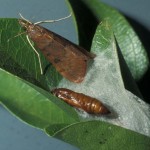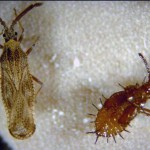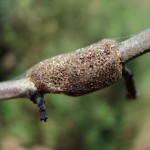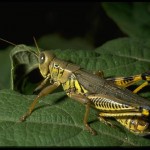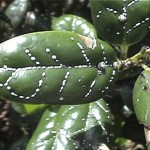- Adult genista caterpillar moth and pupa
- Lantana lace bugs
- Tent caterpillar eggs
- Differential grasshopper
- Florida wax scales
These are the major groups of insects that are considered pests of ornamental plants, but don’t forget about the beneficial insects of ornamentals!
Some links will take you to the Agrilife Bookstore, which houses and updates all Agrilife publications so that we can make the latest information available. Those links will be noted with (Agrilife Bookstore) at the end.
Grasshoppers, Crickets and Katydids (Orthoptera)
- Grasshoppers (Agrilife Bookstore)
- Crickets and Katydids
Rasping Insects
Insects with rasping mouthparts feed by rasping, scraping or slicing the surface of the plant tissue and sucking out the fluids from the ruptured cells. Mites and thrips are in this category. Read more about rasping mouthparts here.
Sucking Insects
Sucking insects feed by puncturing plant parts with long, straw-like mouthparts and removing sap, causing plant stress and sometimes making plants appear wilted. Read more about sucking mouthparts here.
- Aphids
- Whiteflies (Agrilife Bookstore)
- Lace bugs
- Boxelder bugs (Agrilife Bookstore)
- Scale insects and mealybugs
- Scale insects (Agrilife Bookstore)
- Florida wax scales
- Cycad Aulacaspis scale
- Pink hibiscus mealybug (Agrilife Bookstore)
- Catfacing Insects on Peaches (plant bugs, stink bugs)
Caterpillars And Moths
- Bagworms
- Genista caterpillars on Texas mountain laurel
- Spring and fall cankerworms
- Tent caterpillars (Agrilife Bookstore)
- Fall webworm (Agrilife Bookstore)
- Walnut caterpillar (Agrilife Bookstore)
- Homeowner’s Guide to Pests of Peaches, Plums and Pecans (Agrilife Bookstore)
- Oak Leaf Roller and Springtime Defoliation of Live Oak Trees (Agrilife Bookstore)
- Moth Identification – images from Dr. Pat Porter
Beetles (Coleoptera)
- Wood-boring Beetles
- Elm Leaf Beetle (Agrilife Bookstore)
- Managing the Flatheaded Appletree Borer – (Agrilife E-publications)
- Protecting Elm Trees from Elm Bark Beetles on the Texas High Plains (Agrilife Bookstore)
- Plum Curculio – (Agrilife E-publications)
Flies (Diptera)
- Biology and Management of Liriomyza Leafminers in Greenhouse Ornamental Crops – (Agrilife E-publications)
Ants, Bees and Wasps (Hymenoptera)
- Pest ants
- Cynipid wasps
- Pine Sawflies (Agrilife E-publications)
Insect and Arthropod Pests of Plants Species or Groups
- Insect Pests of Conifers
- Managing Insect Pests of Cacti and Other Succulents in Water-Efficient Landscapes (Agrilife Bookstore)
- Lantana and Verbena: How to Control Insect and Mite Pests (Agrilife E-publications)
- Insect Pests of Crape Myrtles (Agrilife E-publications)
- Field Guide to Insects and Mites of Pecan (Agrilife Bookstore)
- Homeowner’s Guide to Pests of Peaches, Plums and Pecans (Agrilife Bookstore)
- Insects Associated with Woody Ornamentals (Agrilife E-publications)
Exotic Pests and Diseases
Exotic pests are species of organisms that are not not indigenous or native to an area. Exotic pests are introduced either accidentally or intentionally to a particular region and grow to be pest status. The significance of exotic pests depends on the species and the invaded area. The red imported fire ant is probably the most notorious exotic pest. Fire ants were accidentally introduced to the U.S. more than 75 years ago from South America to the shipping port of Mobile, Alabama. See Invasive Species in Texas.

